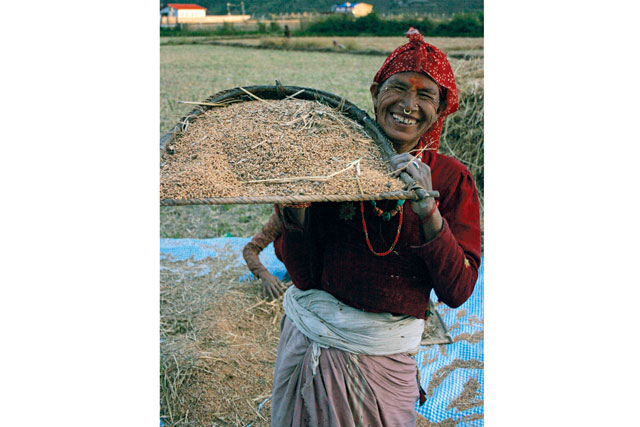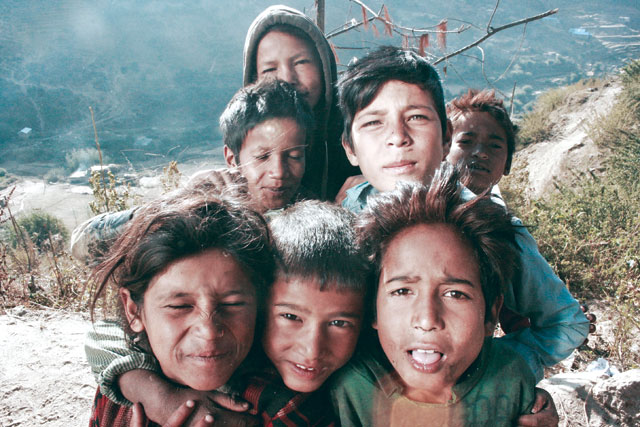Calling all adventurers who want a taste of the “real Nepal”. I invite you to the Karnali Zone, where lies a district called Jumla. Jumla has remained untouched by Western tourism, and locals brag that a visit here is a taste of real Nepali life. Locals also eagerly inform you that the Nepali language originated here.

While an invitation to “real” Nepal sounds enchanting, I can attest that Jumla is not for the faint of heart or those who prefer luxury. The only public hotel I found during my month there was, in reality, someone’s attic, which was only accessible by climbing multiple flights of stairs. I use the term “stairs” loosely, as they were really more like ladders. With limited public accommodations, you will find yourself dependent upon the hospitality of local Jumli people. While I would honestly recommend everyone to visit Jumla, it must be pointed out that if you do not have any ability in the Nepali language, this could be a trying region to thrive in.
The Nepali language was actually one of the main contributing factors in my venture to Jumla. As a student at the Bishwa Bhasa Campus of Tribhuvan University, time outside of Kathmandu is hard to manage. However, the campus was closed the entire month of October 2016 for the back-to-back festivals of Dashain and Tihar. This seemed like a perfect time to escape the city life and grow in fluency by putting my Nepali vocabulary and knowledge to the test.
While flying the whole way from Kathmandu to Jumla Bazaar is possible, it just seemed too “Western” and removed from the local way of traveling. So, my friends and I decided to go via road. We took a night bus from Kathmandu to Nepalgunj. All we had heard about Nepalgunj was how boring it was and how hot and miserable a visit there would be. We found the total opposite—except for the hot part. We stayed in a little hotel that had a pleasant staff and air-conditioned rooms that made the heat much more bearable. We found rickshaws (very different from the ones in Thamel) and began to explore. We found a gem of a place called Candy’s Village, and I can tell you that you should assuredly eat there if you are ever in Nepalgunj. Their menu ranges from chicken and waffles to any burger you can imagine (you can thank me later).
From Nepalgunj, we decided to rent a jeep for the remainder of the trip to Jumla Bazaar. During the following 19+ hour drive, we determined we would fly back. The poor quality of the road from Nepalgunj to Jumla Bazaar would be hard to dramatize. However, the bruises and cuts from being thrown around the jeep were accompanied with a fair share of laughter—it may be worth jeep-ing once; these are the kind of roadtrips you will forever remember.

Sixty hours lapsed between the time we left Kathmandu and arrived in Jumla Bazaar. We were greeted on arrival by a friend we had met in Kathmandu. The fresh and crisp air was such a reprieve from polluted, dusty Kathmandu. As we brushed our teeth that evening outside, we looked up and all we could see from one horizon to the other were brightly shining stars. There was no man-made light pollution, just the whimsical light from the stars and moon above.
We spent our first week in the bazaar. People were fascinated with the foreigners who had seemingly come to stay, and were intrigued with our (limited) Nepali. It only took a few sentences in any conversation for people to correctly deduce that we lived in Kathmandu. We were informed repeatedly that we spoke Nepali like Newaris. This usually led to a history lesson about the Nepali language originating in Jumla, and their pride in speaking pure Nepali. Being disconnected from wifi was quite refreshing. There was no service with which to post our epic photos of village life to social media for the likes and praise of friends back home. We were just there, to be present in the moment and embrace the tension between the joy of living simply, and the challenge of living primitively.
The season we spent in Jumla happened to be the harvesting season. Fresh Jumli apples were available in abundance, and anytime you visited someone’s house, you were sure to be “encouraged” to eat your fill of apples. Ten apples in one day was my record. The rice harvesting season was also in full swing. Families were together in their fields from sunrise to sunset and beyond; first cutting and then binding, beating and finally sifting the rice. Families were eager to have our help. Relationship exploded over our hours in the fields with families. (As did our sun tan/burns). Such friendship cannot be forged over video games or watching movies.
Trekking was not our goal or our intention behind going to Jumla, but while out there along the border of the wild west of Nepal; we could not be content to stay solely in Jumla Bazaar. We set our sights on a little village called Narakot, and took a local bus for what we were told would be a two to four-hour ride. Seven hours later, we arrived. This is where we found the attic hotel, and a tiny restaurant where we ate many meals, nearly wiping out the restaurant’s supply of food each meal.
While the restaurant was pleasant and a comforting fall back if we had no alternative dining options, my favorite meals were those we ate with families in their homes. Most meals were, of course, daal bhaat; but we had many variations of the dish. Many children from this village go to boarding schools in bigger cities in the area, but were home for the holidays. Family life in the village is so refreshing. While it requires much hard work from every family member, bonds between parents and children are strong. There is a constant sound of laughter while mothers and daughters prepare meals over an open fire the husband and sons tend to. We brought along a guitar, and playing it while singing together became a favorite after-dinner activity for everyone.
A river wound around the edge of the village. Now, mind you, Jumla is always cooler than Kathmandu, and this water comes down from snowmelt atop a mountain. We were there in September, so you can imagine how icy the water was. Over this river was a bridge with no handrails—a bridge any child dreams of jumping off from. The river gets deeper just below the bridge, creating the perfect pool for jumping into. While I have cliff-jumped in Tennessee, and this jump was only 12 feet or so at maximum, there was an irresistible call to me to take the leap anyway. This siren call became inescapable as children of the village began to jump, and then flip off this bridge. They assured me it was deep enough for someone as tall as me to jump, and for some reason, I believed them long enough to take the plunge. They were right, it was deep enough! As I emerged from the river, frozen, regret raised its head only to be silenced by the laughing children and their proud declaration that I was the first bideshi (foreigner) to ever jump off the bridge. Whether that status is true or not, I did not care to press. I simply turned it into a badge of honor that I still wear with pride.

One special family that sort of adopted two of my friends and I were the raksi (alcohol) makers for the whole village.Coming from Appalachia in America and seeing the still the family used down by the river to make the raksi, it was evident to me that the beverage was closer to moonshine than the bottled variety you can buy here in Kathmandu. Our friends eagerly showed us their procedure in making the substance; while I am not sure that skill is a resume booster, it surely was fun life experience. As we watched villagers come by, after a day of harvesting, to purchase the freshly made beverage, we realized being the village raksi makers is a quite profitable endeavor.
After making our way back to Jumla Bazaar and spending a few more days there, we began preparations for our journey back east. The prospect of another 19-hour jeep ride was more than we could handle after such a refreshing month in the wide expanses of Jumla’s nature. So, we voted to fly from Jumla Bazaar to Nepalgunj. You may think I am exaggerating, but we scheduled our itinerary around being able to go back to Candy’s Village in between landing in Nepalgunj and boarding the night bus back to Kathmandu! I am happy to report the Western food was as delicious as we imagined following a month of daal bhaat.
This article was intended to be somewhat of a sales pitch for you to go and visit Jumla; I realize now that it was more of a testimonial.While I could drone on with nitty gritty details about various aspects and put together a list of things to expect, that feels counterproductive. For one, we all know that a list of what to expect in any part of Nepal changes constantly; what was true for my trip could be slightly to dramatically different from yours. I think testimonies are what stir us to action. An article telling of adventure, the western frontier, no wifi, no running water, filtering river water to drink, sleeping in attics with holes in the roof that let you peer into the million star canopy above you, a total absence of luxury, living alongside Nepali people, getting workouts in the harvest fields, and eating daal bhaat every day speaks to some of us. If that is you—a trip to Jumla is a must. If you are such a person, you would be slightly disappointed if I told you every detail and ruined the mystery and adventure that awaits you in going west.










